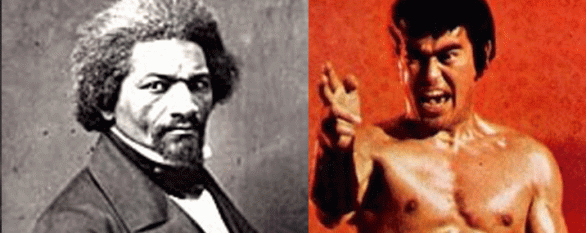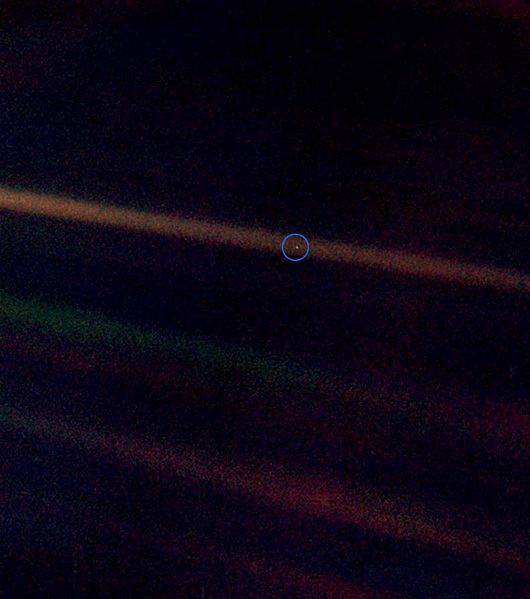This month’s Bloggers For Peace Challenge is about quotes. Specifically, we are to post a quotation that will bring peace to the world.
The first thing that popped into my head when I read that was Carl Sagan.
In 1990, Voyager 1 took a picture of Earth from a record distance of about 3.7 billion miles (6 billion kilometers). In the photograph, Earth is shown as a tiny dot (0.12 pixel in size) against the vastness of space.
Think about that for a second. The Earth, our home, has a radius of only 3,959 miles (6,371 km) with a surface area of 139.43 million square miles (361.132 million sq. km). We tend to think that’s pretty big. There’s plenty of room for lots of different kinds of climates and creatures. It houses all of our history. All of it from Galileo to Gustav Mahler; from Tyrannosaurus Rex to Neanderthal. Every lizard, bird, fish and person, every single living thing that we know of, has lived out its entire existence in that 139.43 million square miles.
Yet, this is what we look like from the edge of the solar system:

Image from wiki.
The sun, the engine that keeps our solar system moving, is only one of the estimated 200 to 400 billion stars in this galaxy alone. The observable universe is 93 billion light years. Its scale is so vast, we can’t measure it in miles or kilometers because numbers don’t go that high. We had to create a new system of measurement–the light year. Just one light year is about 6 trillion miles (10 trillion kilometers). We live in a universe that has 93 billion of them, and that’s just what we can see so far. There’s a reason earth is technically the center of the universe: we can’t see the whole thing.
All of human existence is but a speck on the timeline of the universe.
Some of you think that concept is pretty scary. Some think that humans and dinosaurs ran around together collecting firewood in the early days, and that the earth is only 6000 years old or so. It was created in only seven days by one person, or deity, if you will.
This post is not intended to be a religious debate. I just wanted to point out that, if you don’t believe in the nearly infinite age and vastness of the universe, you’re missing out on all the wonder. It takes all the spunk and pluck out of our story. The intestinal fortitude, good fortune and absolute doggedness in our very existence is lost.
I don’t find it scary. I find it exhilarating. We do not know what’s out there. If we had all the answers, life would be pretty boring. I am giddy like a schoolgirl when the concept of the universe is mentioned. I find all of this stuff absolutely fascinating. If I had a better head for maths, I might have gone on to be an astrophysicist or cosmologist, but I suck at it.
Had I been alive in a different era, I would be one of those people who packed up all of their belongings in a horse cart and ventured west to climes unknown. Unfortunately, I was born in an era of Google street view. There is only one frontier left to us; that of the solar system and beyond.
It is not me against you. We–you, me, Ghandi and Saddam Hussein–are all Homo sapiens. We are all the same. We have the same basic genetic structure. We’re all bipedal humanoids. The differences between us are quite small in comparison to our similarities. Just like dogs, most of our differences are but a tiny fraction of our genetic code. Dogs share 99.8% of the same DNA. That means this and this are essentially the same:

Images not to scale.
And so are this and this:

Images not to scale.
Do you see how both dogs have four legs, a snout, tail and fur? And how both humans have two eyes, two ears, a nose and a mouth arranged on an oval surface perched atop a neckhole with hair on top and sides? That’s because they’re not that different. All of us in the same species, whether it be Canis lupus familiaris or Homo sapiens, share the same basic genetic structure. We are all mostly the same, no matter how differently we think, act or look. Humans should act more like dogs. They don’t care about size, color or appearances; all they see is dog.
We share the same planet, a pale blue dot in the Virgo Supercluster. We share the same genetic building blocks. We share the same bipedal movement and the same history. We are one species among many on a pretty blue planet wobbling around in infinite space. It’s time we stopped thinking of ourselves as so disparate. It’s time we accepted each other as the same species and stopped killing one another over our differences, don’t you think?
Enough of the preamble. I’ve gotten sidetracked from my quote. Carl Sagan said it better and more succinctly than I can, so I’ll leave you with his words:
From this distant vantage point, the Earth might not seem of any particular interest. But for us, it’s different. Consider again that dot. That’s here. That’s home. That’s us. On it everyone you love, everyone you know, everyone you ever heard of, every human being who ever was, lived out their lives. The aggregate of our joy and suffering, thousands of confident religions, ideologies, and economic doctrines, every hunter and forager, every hero and coward, every creator and destroyer of civilization, every king and peasant, every young couple in love, every mother and father, hopeful child, inventor and explorer, every teacher of morals, every corrupt politician, every “superstar,” every “supreme leader,” every saint and sinner in the history of our species lived there – on a mote of dust suspended in a sunbeam.
The Earth is a very small stage in a vast cosmic arena. Think of the rivers of blood spilled by all those generals and emperors so that in glory and triumph they could become the momentary masters of a fraction of a dot. Think of the endless cruelties visited by the inhabitants of one corner of this pixel on the scarcely distinguishable inhabitants of some other corner. How frequent their misunderstandings, how eager they are to kill one another, how fervent their hatreds. Our posturings, our imagined self-importance, the delusion that we have some privileged position in the universe, are challenged by this point of pale light. Our planet is a lonely speck in the great enveloping cosmic dark. In our obscurity – in all this vastness – there is no hint that help will come from elsewhere to save us from ourselves.
The Earth is the only world known, so far, to harbor life. There is nowhere else, at least in the near future, to which our species could migrate. Visit, yes. Settle, not yet. Like it or not, for the moment, the Earth is where we make our stand. It has been said that astronomy is a humbling and character-building experience. There is perhaps no better demonstration of the folly of human conceits than this distant image of our tiny world. To me, it underscores our responsibility to deal more kindly with one another and to preserve and cherish the pale blue dot, the only home we’ve ever known.
This post is part of Bloggers For Peace.

More Bloggers For Peace:
Envy and Greed – the dust of the world.
September B4peace Post
September’s Blog for Peace — Quote This
Kind of a Stupid Game







